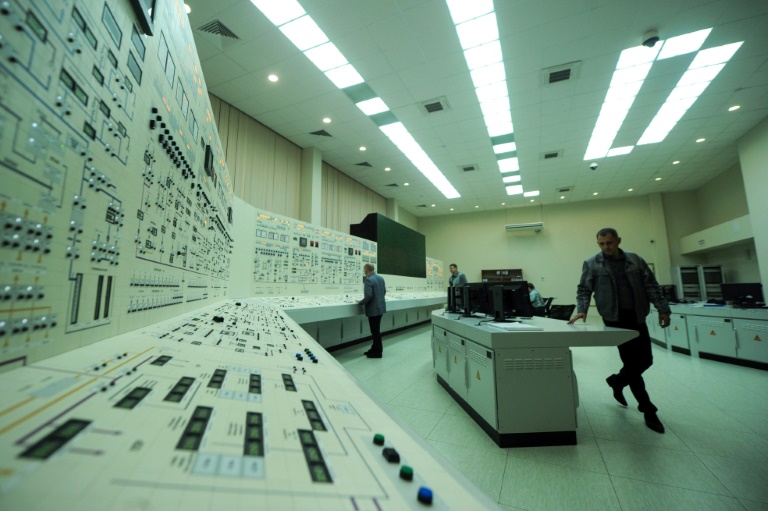Police confirm second suspect arrested for hit inside Wynberg court
Construction of the facility, located in the northwestern Belarusian town of Ostrovets only around 20 kilometres (12 miles) from the Lithuanian border, is entering its final stages.
Its two reactors, each with a capacity of 1,200 megawatts, will be operational from 2019 and 2020 respectively.
The project, approved by strongman Alexander Lukashenko’s government in 2008 and spearheaded by the Russian state energy corporation Rosatom, is being nearly completely financed by Moscow with a $10-billion loan.
The construction of the reactor initially revived bad memories in a country that had a quarter of its territory covered with radiation from the 1986 explosion at the Soviet-era plant in Chernobyl, in present-day Ukraine.
“When we heard that a plant was being built literally outside our windows, we were scared,” said Nina Rybik, a writer who was one of tens of thousands evacuated from contaminated zones 30 years ago.
“But then the fear passed: we were told that advanced technology is being employed to build the station and that every single thing is being controlled,” she told AFP.
She said that even those who had gathered signatures against the construction of the plant were now trying to find work there.
As worries about nuclear safety had been magnified by the 2011 Fukushima disaster in Japan, the local authorities and the Russian contractor actively worked to reassure the nearby population.
To showcase their commitment to safety, Belarusian authorities demanded in 2016 that Rosatom replace equipment damaged during a fall, even though the Russian corporation insisted that the 330-tonne shell had merely touched the ground after sliding down from a four-meter height.
Rosatom calls the reactors “the most modern in the world” and says that they “respect all international norms”.
Belarusian sociologist Elena Martishchenkova said that around half of Belarusians support the development of nuclear energy, with the figure reaching 65 percent in the Ostrovets district this year.
– Balloon ride for EU –
But there is little optimism for nuclear energy on the other side of the border.
Vilnius denounced the project as a violation of “international nuclear and environmental safety requirements”, as it is located 20 kilometres (12 miles) from the EU border and only 40 kilometres from the Lithuanian capital.
Rosatom has repeatedly denied that the project violates international norms.

Russian nuclear firm Rosatom, which is building the reactors, calls them “the most modern in the world”.
But Russia’s long silence about a leak of a radioactive isotope in September, first made public by French authorities, has revived memories about the Soviet Union’s initial denial then downplaying the danger the Chernobyl accident posed.
Rosatom denied last week the ruthenium-106 came from its facilities after Russia’s meteorological service confirmed “extremely high” concentrations of the isotope about 30 kilometres from a site where the firm reprocesses spent nuclear fuel.
In an interview with AFP, Lithuania’s foreign ministry spokeswoman, Rasa Jakilaitiene, accused Minsk of trying to conceal information and minimising the consequences of “at least six incidents” that occurred at the Ostrovets plant in 2016.
In May, the Lithuanian government even flew EU energy chief Maros Sefcofic in a hot air balloon over Vilnius so he could see how close the Belarusian plant was to the city, in an attempt to convince EU officials that the plant represented a health hazard.
The Baltic country even adopted a law declaring the nuclear plant a national security threat.
“In accordance with the law, no electricity from the Ostrovets nuclear power plant will be able to enter the Lithuanian power market, nor the European electricity market,” spokeswoman of Lithuania’s energy ministry Aurelija Vernickaite told AFP.
This closes a potentially important market for the nuclear plant with a capacity that exceeds the needs of Belarus’ relatively small population of 9.5 million people.
Minsk has even considered having factories run overnight in order to use the surplus electricity.
– ‘Very sensitive question’ –
Another thorny issue is the processing of radioactive waste, which the Belarusian government says it is working on.
Constructing the plant was primarily seen as a means for Russia’s Vladimir Putin to extend his economic influence in the former Soviet Union.
It was also seen as offering a helping hand to Lukashenko, who at the time faced an economic crisis aggravated by Western sanctions for his crackdown on the opposition.
But now that most of the sanctions have been lifted — after Lukashenko freed several political prisoners — Minsk is presenting the plant as a means to reduce its dependence on Russian gas, which fuels the power plants that create most of the electricity in Belarus.
Moscow has often used its oil and gas deliveries as a means to influence Belarus and Russia’s other former Soviet neighbours.
“It is a very sensitive security and energy question — dependence on one country, especially if it restricts current energy deliveries,” Alexander Mikhalevich, an expert in nuclear issues at Belarus’ Academy of Sciences, said during a recent energy conference in Minsk.
bur-gmo-apo-oc/as/spm/rl/iw
Download our app